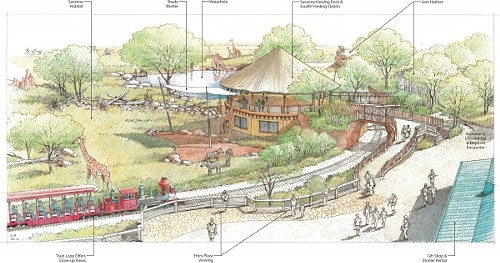With fiscal cliffs and end-of-days fears clouding the end of 2012 and even the start of the new year, it’s sometimes hard to get an optimistic view of the future. But for two Utah institutions dedicated to teaching about the natural world, 2013 is going to be all about the idea that bigger and better days are still to come.
Utah’s Hogle Zoo already opened one successful new expansion in 2012, its Rocky Shores exhibit. For much of 2013, the focus will be on completing the final part of a five-year master plan as a five-acre African Savanna is constructed at the main entrance. The exhibit, scheduled for a spring 2014 opening, will bring lions back to the facility, add a giraffe feeding station and feature many other yet-to-be-determined species.
The Living Planet Aquarium, meanwhile, is undertaking its own even more ambitious expansion. October 2012 marked the groundbreaking for the new Loveland Living Planet Aquarium in Draper, a 136,000-square-foot building that will more than triple the exhibit space at the current Sandy location, include more outreach classrooms, and allow rotating exhibits and attractions such as a 40-foot walk-through “undersea” tunnel. Doors are slated to open in December 2013.
While an economic downturn might seem like an unlikely time to take such steps, the plans have long been under way. The zoo’s renovations are part of the 2008 Renew the Zoo $33 million bond that also required $11 million in private fundraising. The aquarium’s Sandy location, a former retail building, has always been considered temporary, and a combination of a $14 million Draper city bond (scheduled to be repaid by the aquarium over 20 years) and private donations finally led to its new location.
Both institutions have faced unique planning challenges based on their locations—both in terms of being in Utah, and in terms of the facilities’ specific location within the Salt Lake Valley. According to Angie Hyde, marketing director for The Living Planet Aquarium, the space constraints of the current 43,000-square-foot Sandy location have led to crowded exhibits on the busiest days, and overflow from the parking lot to a neighboring (and generously accommodating) grocery store across the street.
Additionally, the facility has had to face the reality that it might never be able to house certain aquatic species—most notably one that’s most frequently inquired-about: dolphins. Because of specific requirements for the number of dolphins that can be housed together, a minimum of four animals would have to be purchased at the same time—a prohibitive cost for the aquarium.
For the zoo, according to marketing director Erica Hansen, there’s always the challenge of being an outdoor facility in a winter-weather state. “One of our goals has been to push people toward the ‘shoulder seasons,’” Hansen says. “They can have one-on-one experiences they may not get in the summer, and at times when animals like the tigers are more active.”
And then there’s the simple matter of the limitations of the zoo’s physical location. “We’re 42 acres and locked on every single side,” Hansen says, “so we want to show animals we think work best with our climate and our acreage.”
Expansions and upgrades are clearly intended to make the facilities more appealing to visitors, yet there’s also the fact that better facilities are more attractive to the best keepers and animal husbandry staff. Hyde describes The Living Planet’s expansion—which involves a nationwide staff search—as a unique opportunity that appeals to animal professionals wanting to “see this process happen, helping design exhibits and acquiring large amounts of animals at one time.”
Hogle Zoo’s Hansen agrees that the quality of the animal exhibits matters in finding the best personnel, but they also matter more to visitors than might have been the case in years past. “Zoo philosophy has changed from 50 years ago,” Hansen says, “where they tried to show as many animals as possible and the homes didn’t matter as much. People now want to see animals in a pleasant-looking place.”
For both The Living Planet Aquarium and Hogle Zoo, meeting the goal of creating places that are most attractive to visitors and staff—as well as good for the animals—is the focus of the current upgrades. But as with all upgrades, there will be some minor inconveniences along the way. Construction at the zoo is requiring the closure of the Zoofari train until the completion of the African Savanna, while some animals from Woodland Edge and Discoveryland will be temporarily relocated. The aquarium, meanwhile, will be closing the Sandy location after Labor Day 2013 to allow the animals to be moved to the new location; pass holders will have their expiration dates extended for the duration of the closure.
The final result, however, will be two facilities that further a similar mission. As Hansen describes it, “What’s most important … is that people are engaging with the environment, making those connections. And Utah has great hands-on places for that.”
More by Scott Renshaw
-
Faces of Salt Lake County book and portrait reception
Images and personal stories in a new book reveal local demographic diversity
- Apr 17, 2024
-
Feature film review: THE BEAST
A filmmaker's compelling ideas get a bit tangled in references to his creative influences.
- Apr 17, 2024
-
Film Reviews: New Releases for April 12
Civil War, Escape from Germany, Coup de Chance, Hundreds of Beavers, La Chimera, Sting
- Apr 11, 2024
- More »
Latest in Arts & Entertainment
Readers also liked…
-
New TV for January 2023
Mayfair Witches, Velma, The Last of Us, Poker Face and more premieres
- Jan 4, 2023




